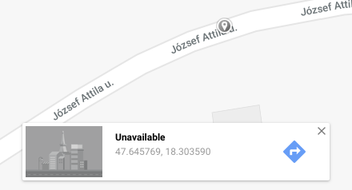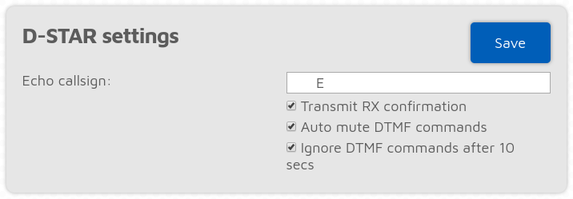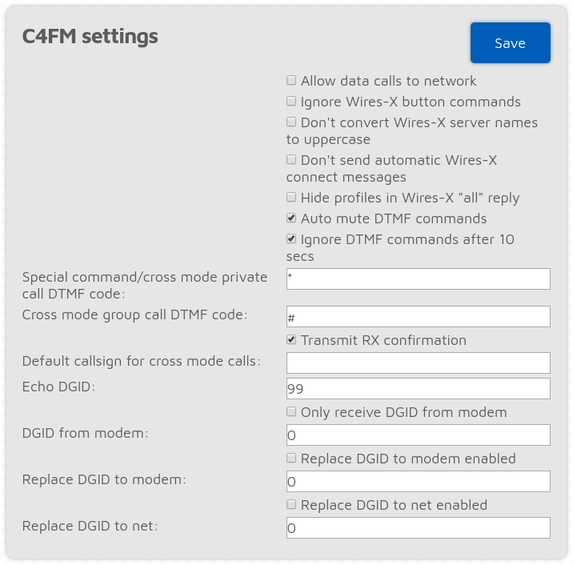Settings page
You can change the general settings of the openSPOT2 on this page.
Configuration profile

You can use 5 different configuration profile slots. You can switch between them on the web interface, or by using your radio (see the Control calls section for more information).
You can rename profiles, copy one to another slot or export/import to/from a file.
By setting the Change after last call setting to non-zero (this setting is available if Advanced mode is enabled), the openSPOT2 will switch to the specified profile slot after a timeout since the last call was received.
The Don't show init setup on login checkbox is checked if the Initialization setup has been completed.
Notes on configuration profiles
- Please keep in mind that all configuration profiles are empty by default, so if you switch to a previously unused profile, the openSPOT2 will start in Wi-Fi AP mode as there will be no configured Wi-Fi networks to connect.
- The openSPOT2 reboots on profile switch.
- Wi-Fi networks and passwords are stored for each profile separately.
- The web interface password is stored for each profile separately.
Firmware upgrade

The openSPOT2 will automatically check for firmware and data upgrades periodically, as specified by the Check interval setting (only available if Advanced mode is enabled). If Automatic upgrade settings are checked then the openSPOT2 will automatically download upgrades.
Data upgrades are applied immediately, but upgrading the firmware requires a reboot to the bootloader. If a new firmware has been downloaded, a reboot will be automatically scheduled for the (local) time set by the Auto upgrade at setting. By default it's set to 4am next day. The reboot will only be performed if there were no calls received for at least Auto upgrade RX/TX delay seconds (this setting is only available if Advanced mode is enabled).
Do NOT unplug the openSPOT2 during the firmware upgrade!
SharkRF Network

You can log your device in to the SharkRF Network. Currently only developers and alpha testers have access to the network's features. Eventually, these features will be available for all openSPOT2 users.
Voice announcements

The openSPOT2 has an own, built-in voice announcement system. Some announcements are played locally from the openSPOT2's built-in flash memory, but some are played using our open source voice announcement server.
Modem mode notes:
- DMR: voice announcements are sent to TG9, so to hear them, make sure you have TG9 in your radio's RX group list.
- NXDN: voice announcements are sent to TG0.
- P25: voice announcements are sent to TG9.
If you enable Advanced mode, the following settings will show up:
- You can shorten profile announcements by checking the Shortened profile announcement checkbox.
- If you don't want to hear the linked reflector/talkgroups list, then you can shorten BrandMeister announcements by checking the Shortened BrandMeister announcement checkbox.
- You can disable built-in voice announcements by checking the Use server only checkbox. Note that startup voice announcements played right after the openSPOT2 boots will still be played from the openSPOT2's flash memory.
- You can set your own voice announcement server's host and port.
- Net state announcement int. sets the interval of the announcement if the openSPOT2 can't connect to a Wi-Fi network.
See the Control calls section for more information about Profile query/change base ID, Connector query ID and IP address query ID.
Location settings

Setting location data is optional. It is used by some connectors like the Homebrew/MMDVM to report the location of the openSPOT2 to the connector's network.
Latitude and longitude is in decimal degrees. Google Maps will display a location's coordinates in decimal degrees if you click on it:

Both height values refer to the height of your openSPOT2 (they are used separately).
DMR settings

The modem will only process DMR calls with a matching Color code.
If the source callsign of a cross mode call has no associated DMR ID, and it can't be parsed into a number, then the Default cross mode source DMR ID will be used for the outgoing DMR call. If you are the only person using the openSPOT2, set this to your DMR ID, and then you don't need to change the callsign of your radio to your DMR ID.
If Advanced mode is enabled, the following settings show up:
If a call is received by the modem to the Echo ID, then the openSPOT2's built-in local echo service gets activated. It will record the call and plays it back after the call is finished. Both private and group calls are answered with a private echo call reply.
If the Allow only IDs as cross mode callsigns setting is enabled, and the source callsign of a cross mode call has no associated ID in the database, and also it can't be parsed into a DMR ID, then the call will be ignored.
If the Force source ID from modem is set to other than 0, the source DMR ID of all voice calls received by the modem will be replaced with this ID.
If the Send no in-band data to network setting is enabled, then in-band data coming from the modem (like the talker alias or in-band GPS position information) won't be sent to the network.
If the Force talker alias to DMR network is set, then this talker alias will be sent for all calls coming from the modem.
If the Send no in-band data to modem setting is enabled, then the openSPOT2 will remove all in-band data from calls coming from the network. By default this setting is enabled. If you have a radio which supports talker alias decoding (like Hyteras with at least firmware version v8), turn off this setting to let the openSPOT2 pass through in-band data to your radio. If you have a radio which does not support talker alias decoding, turn on this setting to prevent issues with decoding voice calls containing in-band data (voice stuttering, calls dropping etc.).
D-STAR settings

This section is only available if Advanced mode is enabled.
If a call is received by the modem to the Echo callsign, then the openSPOT2's built-in local echo service gets activated. It will record the call and plays it back after the call is finished.
If the Transmit RX confirmation checkbox is checked, the openSPOT2 will transmit a short call confirmation after the PTT is released on the D-STAR radio.
If the Auto mute DTMF commands checkbox is checked and a call is ongoing from the modem, and a DTMF sequence is being entered, then the call to the network will be automatically ended, so others won't be annoyed by hearing your DTMF tones on the same reflector/gateway.
If the Ignore DTMF commands after 10 secs checkbox is checked, then all DTMF commands will be ignored after 10 seconds have elapsed since call start. This is useful to avoid any mistakenly entered and decoded DTMF commands.
C4FM/Fusion settings

This section is only available if Advanced mode is enabled.
- Allow data calls to network: if enabled, data calls will be forwarded from the modem to the network. This is not required for normal operation.
- Ignore Wires-X button commands: Wires-X button commands received by the modem will be ignored in case this settings is enabled.
- Do not convert Wires-X server names to uppercase: all server names sent to the transceiver are converted to uppercase by default, and space characters are replaced with dashes. This conversion can be turned off with this setting. The conversion is done because some radios (like the Yaesu FT70) do not show lowercase characters on their displays, and space characters prevent the radio from saving the current server to a category.
- Don't send automatic Wires-X connect messages: the openSPOT2 automatically sends Wires-X connect messages in case it connects or disconnects to/from a server. These automatic messages can be disabled with this setting.
- Hide profiles in Wires-X "all" reply: if this setting is enabled, configuration profiles won't be listed on the first page for a Wires-X "all" server search.
- Auto mute DTMF commands: if a call is ongoing from the modem, and a DTMF sequence is being entered, and the first character is a Special command / cross mode private call or Cross mode group call DTMF code, the outgoing call to the network will be automatically ended, so others won't be annoyed by hearing your DTMF tones on the same reflector/talkgroup.
- Ignore DTMF commands after 10 secs: if this checkbox is checked, then all DTMF commands will be ignored after 10 seconds have elapsed since call start. This is useful to avoid any mistakenly entered and decoded DTMF commands.
- Special command/cross mode private call DTMF code: this code is used as the first character for entering a control DTMF code, or starting a private call in cross modem modes. See more info at each connector's description, or at the Control calls section.
- Cross mode group call DTMF code: if a connector is active which supports group calls and C4FM cross mode, then this code can be used to start group calls to the ID entered after this code.
- If Transmit RX confirmation is checked, then the openSPOT2 will transmit a short call confirmation after the PTT is released on the C4FM radio.
Default callsign for cross mode calls: this callsign will be used on C4FM networks for calls coming from a radio which does not have a callsign (ex. DMR, NXDN ID) instead of using the IDs as callsigns.
Note that if the incoming call's talker alias is decoded, then it will be used instead of this default callsign setting.
- If a call is received by the modem to the Echo DGID, then the openSPOT2's built-in local echo service gets activated. It will record the call and plays it back after the call is finished.
- If the Only receive DGID from modem checkbox is checked, then calls only to the specified DGID from modem will be processed by the modem.
- If the Replace DGID to modem enabled checkbox is checked, then the DGID in all frames received from the network will be replaced with the specified Replace DGID to modem value.
- If the Replace DGID to net enabled checkbox is checked, then the DGID in all frames received from the modem will be replaced with the specified Replace DGID to net value.
NXDN settings

- The modem will only process NXDN calls with a matching Radio Access Number if it is set other than 0.
If a call is coming from a mode which does not have ID information (ex. C4FM), or the source ID is outside the NXDN ID range (0-65535), then the Default cross mode source ID will be used as the source ID for the call. This ID will always be used if the Always use this ID in cross mode checkbox is checked.
If you use a non-NXDN network with your NXDN radio, you can set this to your NXDN ID.
If Advanced mode is enabled, the following settings show up:
- If a call is received by the modem to the Echo ID, then the openSPOT2's built-in local echo service gets activated. It will record the call and plays it back after the call is finished. Both private and group calls are answered with a private echo call reply.
- If a call is coming from a mode which does not have ID information (ex. C4FM), or the destination ID is outside the NXDN ID range (0-65535), then the Default cross mode destination ID will be used as the destination ID for the call. This ID will always be used if the Always use this ID in cross mode checkbox is checked.
- If the Allow only IDs as cross mode callsigns setting is enabled, and the source callsign of a cross mode call has no associated ID in the database, and also it can't be parsed into an NXDN ID, then the call will be ignored.
P25 settings

The modem will only process P25 calls with a matching Network Access Code (NAC). Note that the openSPOT2 requires the NAC in decimal format (example: if you have the NAC 0x293 in your radio then you have to enter 659 in the openSPOT2).
If the source callsign of a cross mode call has no associated DMR/P25/CCS7 ID, and it can't be parsed into a number, then the Default cross mode source P25 ID will be used for the outgoing P25 call. If you are the only person using the openSPOT2, set this to your DMR/P25/CCS7 ID, and then you don't need to change the callsign of your radio to your DMR/P25/CCS7 ID.
If Advanced mode is enabled, the following settings show up:
If a call is received by the modem to the Echo ID, then the openSPOT2's built-in local echo service gets activated. It will record the call and plays it back after the call is finished. Both private and group calls are answered with a private echo call reply.
If the Allow only IDs as cross mode callsigns setting is enabled, and the source callsign of a cross mode call has no associated ID in the database, and also it can't be parsed into a DMR/P25/CCS7 ID, then the call will be ignored.
POCSAG settings

This section is only available if Advanced mode is enabled.
If the modem is transmitting POCSAG messages then it will switch to the POCSAG frequency. The TX delay in other modem modes setting specifies how many seconds the openSPOT2 should wait after the last call has been finished to switch to POCSAG mode and start transmitting the queued messages.
There are 16 timeslots for POCSAG, these timeslot settings can be overridden by the DAPNET server when the DAPNET connector is connected unless the Do not allow DAPNET to override timeslots checkbox is checked. Each timeslot is 6.4 seconds long. The openSPOT2 will only start transmitting POCSAG messages if the current timeslot is allowed.
Lock settings

This section is only available if Advanced mode is enabled.
These settings allows you to lock the openSPOT2 to the given IDs and/or callsigns. If lock is enabled, the openSPOT2's modem will only allow calls originating from the given IDs or callsigns.
Miscellaneous settings

If Advanced mode is enabled, you can set the openSPOT2's LED brightness with the slider. Please note that the new brightness setting will be only applied by the openSPOT2 at the next LED state change.
There are also some buttons for reboot and config profile reset actions.